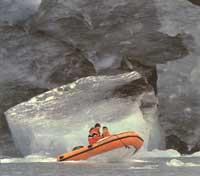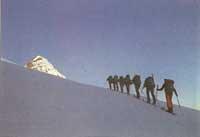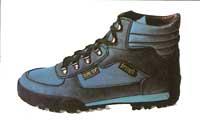Nice and suitable mountain clothing
Elhuyar Fundazioa

Most mountaineers who are not very young will take into account the type of clothing and equipment with which they went on their first exits to the mountain. To go to the mountain were used clothes and shoes discarded that normally were not able to wear on the street. There were very few who had special clothing and footwear for the mountain and also looked at them with a little suspicion, as if they had thrown money useless. If it was a good day, but if rain or cold day came out it was not very pleasant.
Those who have suffered all these fatigue and have remained without losing their love of mountaineering know well the effort they have made to complete and improve their equipment. In order for sport and hiking to be pleasant, it is essential to meet minimum requirements.
Today more importance is given than ever to the comfort and quality that should have clothing and footwear. There are suitable, beautiful and sophisticated teams to do sports like never before. The number of people traveling in the mountains has also grown a lot and Basque mountaineers have achieved better marks and are organizing numerous expeditions.
But you have to prepare it well. Fortunately, much progress has been made in the field of sportswear and manufacturers are continuously researching new materials and systems to offer maximum comfort.
Manufacturers sought suitable materials to overcome the obstacles that cause rain and sweat. The key was to get a suitable fabric waterproof to the outside humidity but able to eliminate at the same time the interior humidity produced by sweat.

The desire to get clothes that offer this opportunity is very old. Before World War II, for example, researchers at the Shirley Institute in Manchester embarked on the search for suitable materials for work and sports practice and the research carried out led the British Textile Technology Group team of this institute to get a very waterproof fabric called Ventitile. In order to obtain this fabric, the size of the fiber and the type of warp were taken into account. This fabric had pores that prevented rainwater drops from entering, but allowed indoor air and humidity to come out.
When the fiber gets wet, this effect multiplies. Wet fibres swell further reducing empty warp spaces. If before the pores were 10 microns, once wet they are reduced from 3 to 4 microns. Keep in mind that human sweat molecules have a diameter of 0.0004 microns and smaller water drops measure more than 100 microns. Therefore, it is easy to understand that in this waterproof fabric rain cannot enter, but that sweating will come out.
However, these narrow weft fabrics are heavy and difficult to use, especially when they are soaked after a long period of time in the rain.
Thus, in the early 1970s, researchers began to look for lighter respiratory tissues and the research carried out was by two means:
- Some studies focused on the study of hydrophilic polymers present on the outside of the garments. In general they are polyurethanes that limit rain, but do not prevent the total diffusion of water vapor molecules.
- Other studies aimed to study the microporous membranes that stick inside the tissues. These membranes have smaller pores than narrow weft tissues, but generally perform the same function.

Recent research on hydrophilic polyurethanes has analyzed the influence of some effects and factors. They have sought to find a product that resists bending, abrasion, oxygen, ozone, microbial shock and dry cleaning and cleaning. The polymer must also be durable, smooth at low temperatures and glued to other fibers.
Urethane monomers are obtained from the reaction of some diisocyanates and diols. Subsequently, different polyurethanes are obtained through polymerization. There are many diisosocianates and dioles, so there is where to choose. Different polyurethanes are obtained with each combination. Polyurethane becomes hydrophilic in polymer chains through polyethylene oxide bonds.
Chemists try to get suitable copolymers by playing with different types and amounts of monomers. The so-called strong segments blend with soft segments for strength and durability, flexibility and softness. These segments are alternating in each polymer chain. At the temperatures applied to the garments, the chains move constantly forming a variable axis in which the pores appear and disappear continuously in the molecules. These intermolecular pores are large enough to allow the diffusion of air molecules, but they are waterproof to water.
As the pressure of the water vapour on the inside of the clothes rises. As a result, as the pressure of the external water vapor is lower, an indoor-outdoor diffusion process occurs. When the outside humidity is high, the behavior of hydrophilic polymers is usually limited. Therefore, they are not suitable for places with high humidity, such as Florida USA.

WL GORE Delaware has developed a microporous membrane fabric called GORE-TEX. It consists of a thin layer of polytetrafluoroethylene (PTFE), better known as teflon obtained by stretching and annealing. This process produces a membrane formed by a network of PTFE nodes that bind together by small and thin PTFE fibers.
Normally the grille pores are smaller in diameter than the micron. The gore-tex membrane adheres to various fabrics by means of joints. Again the pores let steam out of moisture, but they are too small to filter water drops.
Microporous membranes initially faced the action of substances such as surface oils, pesticide residues, insect repellents, sun cream, etc. These reduced membrane resistance. As a result, the resistance to water inlet was weakened, partially losing the impermeability. One way to solve the problem is the membrane coating with hydrophilic polymer.
The Gore house has been covered with hydrophilic polymers by the membrane extended by its PTFE and in June 1988 the brand was patented. Therefore, manufacturers of this type of clothing will have the possibility of obtaining material with microporous membrane and in turn with hydrophilic coating.
Today, clothing manufacturers produce curious things with polymers. Both with the size of the fiber and with the fabric and finish the most suitable product is achieved and seeks to achieve the best durability, impermeability, excretion, lightness and softness for each garment. It is up to the consumer to choose the clothes that suit their needs.

For the mountain and for any sport in general, garments with the ability to expel sweat are very suitable. However, many things can still be improved. At present almost waterproof clothing has been achieved, but there are still some obstacles that hinder its use. For example, when we turn the head to one side, the cap does not adapt properly to the movement of the head. This error will certainly be fixed shortly.
We are offered increasingly simple ways to boost mountaineering. They have forgotten the hardships and obstacles of yesteryear, there are no great excuses to enjoy the beauty and tranquility that nature offers us walking through the mountain. Therefore, do not forget the mountain that we have always had the Basques and enjoy the amenities offered by the technique.





